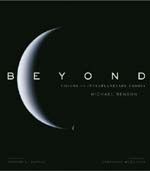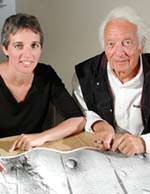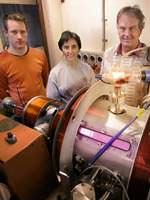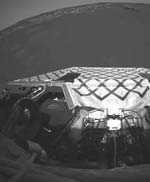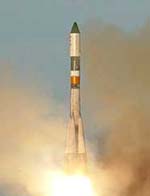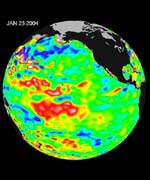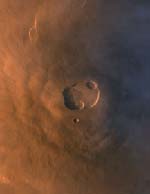
Image credit: NASA/JPL
The current generation of Mars missions have adopted the theme, “Follow the Water”, as a quest to understand the complex geological history of a planet that may have had significant reserves once. For that much warmer and wetter Mars, this motto also requires other ingredients for microbial life, including primordial “fire” in the form of biological temperature ranges.
The global picture of Mars is sometimes compared terrestrially to Antarctic dry regions, only colder. The surface temperature averages -64 F (-53 C), but varies between 200 below zero during polar nights to 80 F (27 C) at midday peaks near the equator. Such temperature extremes suggest that to realize a locally warmer Mars today may require extra heat, such as near a geothermal source.
To consider such interesting places where martian fire might work with other primordial elements like soil, wind and water to give unique science opportunities, Astrobiology Magazine had the chance to talk with Tracy Gregg, Ph.D., assistant professor of geology at the University of Buffalo and chair of the Planetary Geology Division of the Geological Society of America.
Astrobiology Magazine (AM): Given the Pathfinder and Spirit successes with airbag landings, does this descent method make scientists interested in going to places more challenging, like near volcanoes?
Dr. Tracy Gregg (TG): With the success of Spirit, I feel so much more confident about future Mars landers. The airbags seem to be able to withstand quite a bit of trauma. If both of these [Opportunity and Spirit] landers survive with airbag technology, then it blows the doors wide open for future Mars landing sites with far more interesting terrain.
A landing site near a volcano might be possible, now that the airbag technology has worked so wonderfully.
AM: Isn’t Spirit’s landing site at Gusev crater southeast about 120 miles from Apollinaris Patera, and so would that interest include taking a trip back to the Gusev region?
TG: I’d like to see us land ON a volcano. Right on the flanks.
AM: As a geologist, is there interest in the evidence for layering at Meridiani for the Opportunity mission to explore? Would that be sediment or volcanic layering?
TG: Probably some of both. There is a high possibility that we will get to see layers of ancient rock, deposited when Mars was warm and wet and could have supported life. Evidence of river channels, which we expect to see at Sinus Meridiani, could be remnants of that early, warm history. Those layers could be lava flows. Often the best place to look for evidence of life on any planet is near volcanoes.
That may sound counterintuitive, but think about Yellowstone National Park, which really is nothing but a huge volcano. Even when the weather in Wyoming is 20 below zero, all the geysers, which are fed by volcanic heat, are swarming with bacteria and all kinds of happy little things cruising around in the water. So, since we think that the necessary ingredients for life on earth were water and heat, we are looking for the same things on Mars, and while we definitely have evidence of water there, we still are looking for a source of heat.
AM: On the surface, what would exposed hematite look like in pictures? Matt Golombek, the project scientist for Pathfinder and a current rover science team member, indicated that Meridiani will look totally different from Gusev, with a grey, basaltic landscape. Are there any places on Earth that might give a tie-point to anticipating what the images will show?
TG: It depends what “pictures” you’re talking about and how fine-grained the hematite is. Hematite, if sufficiently abundant on the surface, may make the surface black and sparkly to a human eye. But it’s more likely to be observed using the special tools Spirit is equipped with–microscopic imagers and a spectrometer.
AM: Where are large hematite deposits found on Earth, and is their history terrestrially always tied to water?
TG: I’m not sure off the top of my head where they are globally–there are some huge deposits in the north-central US (think about the Minnestota and Michigan mining histories). Certainly on Earth they only form in the presence of large volumes of water.
AM: Is it correct to say that there are no active surface volcanoes on Mars today?
TG: If you’d asked me that 10 years ago–or even 5–I might’ve said yes. Now I’m not so sure.
AM: Do you think there is geological interest in landing in higher latitudes, nearer the martian poles?
TG: YES.
AM: Would the rocks be less interesting at higher latitudes but the seasons more interesting because of the presence of frost and the annual melting exchanges that happen between ice and dry-ice subliming at different rates?
TG: Higher latitudes are interesting to me because that’s where the large volcanoes are, and there’s more opportunities for magma/water interactions. Those interactions are probably extremely important for the origin and evolution of life.
AM: Are there alternatives to airbags and rocket landings?
TG: Sure, but so far airbags seem to work the best.
AM: Do you have an opinion about a sample return mission to Mars, using the Stardust mission profile–in which a projectile is dropped on the surface and that kicked-up dust is then flown through with a capture device from orbit?
TG: I’m a volcanologist who studies lava flows. I’m most interested in hard lava, or indurated volcanic ash. I’d much rather see a rock hammer go to Mars than a dust bin. However, any sample return would reveal a phenomenal amount of information about the surface processes operating on Mars.
I’d embrace any sample over none…
AM: If you were to guess at where the best chance to find active volcanology today on Mars might be, can you describe that spot briefly? For instance would this be a shield volcano visible on the surface, or some kind of subterranean magma chamber that is not exposed permanently?
TG: OK, I have to be a little picky here and supply some definitions before I can answer your question. As a planetary volcanologist, I have some pretty specific meanings in mind for certain terms, and I want to be sure you understand where I’m coming from.
Typically, a volcano on Earth is considered to be “active” if it has erupted sometime within the past 10 thousand years. By that definition, a “subterranean magma chamber” in and of itself would not constitute “active” volcanism, if all the activity is beneath the surface.
Can we use those same definitions on Mars to define “active volcanism?” Sure. But should we? I don’t think so.
The 10,000 year cutoff was chosen for Earth both for scientific and practical reasons. Scientifically, we know that it isn’t terribly likely for a given volcanic vent to spout off again if it hasn’t done anything in about 10,000 years. Practically, that’s about the time that the last Ice Age ended, leaving behind remarkable geologic signs–so all we have to do is decide if the volcanic activity is older or younger than the most recent glacial activity.
That’s not something we can do on Mars.
That said, where would I look for recent volcanic activity? Depends on how you want to define it on Mars. I strongly suspect there are still molten (or at least mushy) magma bodies beneath the huge Tharsis volcanoes, and beneath Elysium Mons.
But the youngest surficial activity discovered to date (and it’s probably 1 million years old, which would be considered quite young, and possibly “active” on Mars) is in a region that contains no large volcanic structures of any kind. Instead, there are cracks in the ground, and a few low-lying volcanoes that can’t even be seen except in the high-resolution topography (they are too subtle for imagery to reveal). This area is called Cerberus Fossae.
This tells me that “active” volcanism, if it exists in the terrestrial sense, is probably in the Northern Hemisphere, where the crust is thin, and possibly close to Tharsis or Elysium. But not necessarily.
Original Source: Astrobiology Magazine
